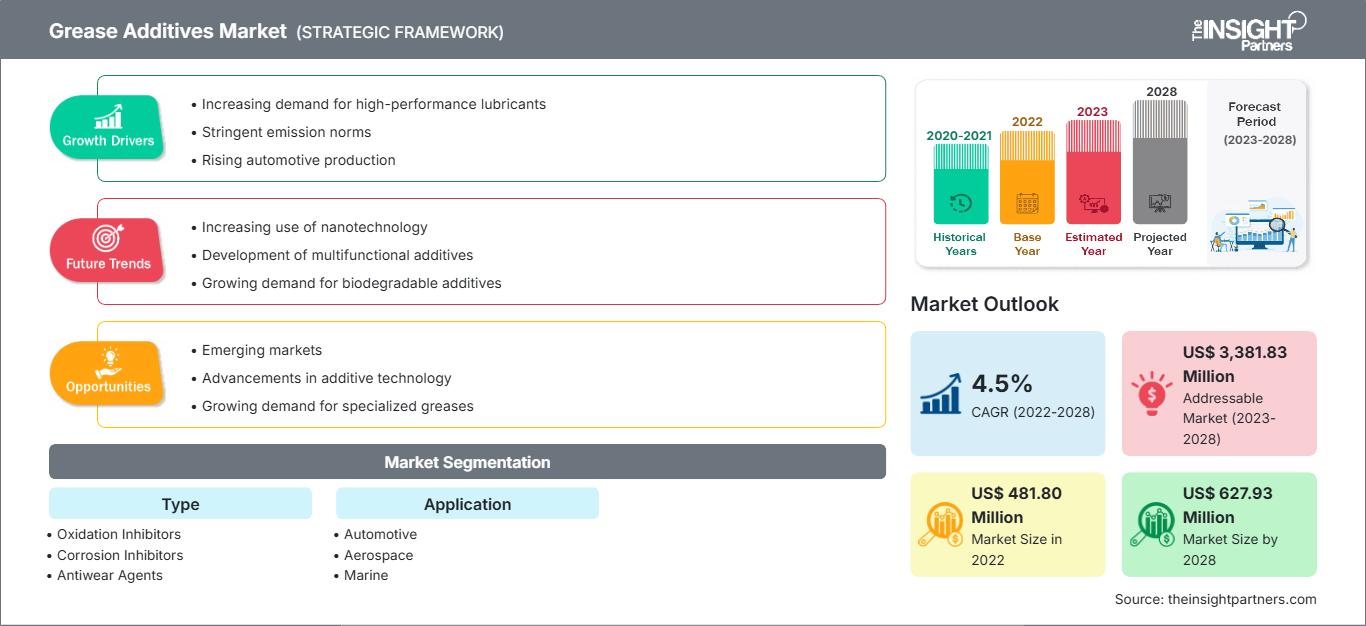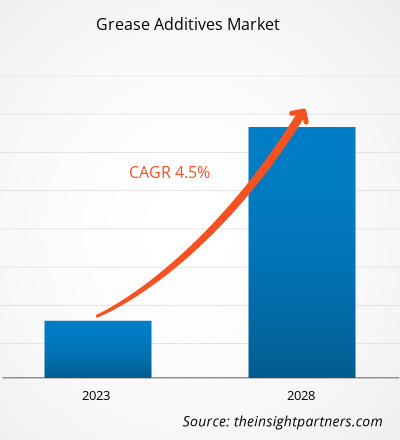[Rapporto di ricerca] Il mercato degli additivi per grassi è stato valutato a 481,80 milioni di dollari nel 2022 e si prevede che raggiungerà i 627,93 milioni di dollari entro il 2028; si stima una crescita a un CAGR del 4,5% dal 2022 al 2028.
Gli additivi per grassi sono sostanze chimiche organiche o inorganiche che vengono disciolte o sospese nell'olio come solidi. L'aumento delle vendite di automobili e veicoli commerciali sta trainando il mercato degli additivi per grassi. Gli additivi per grassi vengono utilizzati nei grassi utilizzati come lubrificanti per migliorare le prestazioni delle apparecchiature e prolungarne la durata.
I grassi industriali sono costituiti principalmente da olio base, addensante e additivi; gli additivi sono il secondo componente più importante dopo l'olio base. Nella produzione di grassi vengono utilizzati tre tipi di oli base: olio minerale, olio vegetale e olio sintetico. I grassi sintetici sono prodotti utilizzando oli sintetici come le polialfaolefine. Sono ampiamente utilizzati nel settore industriale, in particolare nell'industria automobilistica. Le loro caratteristiche superiori, la capacità di garantire costanza operativa e i costi accessibili li rendono una categoria di lubrificanti preferita. I grassi sintetici sono utilizzati in applicazioni che comportano temperature, carichi e velocità estremi. Gli additivi per grassi sintetici migliorano le proprietà fisiche e chimiche aumentando l'indice di viscosità, riducendo la volatilità e il punto di scorrimento dei lubrificanti. Miglioratori dell'indice di viscosità, deprimenti del punto di scorrimento, disperdenti e detergenti sono alcune delle categorie di additivi più utilizzate. Con la crescente domanda di grassi sintetici, è probabile che la necessità di additivi per questi grassi aumenti durante il periodo di previsione.
Diversi importanti attori del mercato stanno sviluppando additivi per grassi sintetici per migliorarne l'efficienza. Ad esempio, a settembre 2022, Clariant ha lanciato additivi per pressioni estreme/antiusura, miglioratori della lubrificazione, inibitori di corrosione, agenti neutralizzanti e formulazioni guida per fluidi per la lavorazione dei metalli completamente sintetici che aumentano l'efficienza delle macchine. Pertanto, con la crescente domanda di grassi sintetici, gli additivi utilizzati in questi grassi stanno introducendo nuove tendenze nel mercato degli additivi per grassi.
Nel 2022, l'Asia-Pacifico ha detenuto la quota maggiore del mercato degli additivi per grassi e si stima che registrerà il CAGR più elevato durante il periodo di previsione. L'Europa è un'altra regione interessante e detiene una quota di mercato importante. La crescente installazione di impianti eolici onshore e offshore e l'aumento della scala della produzione automobilistica contribuiscono alla crescita del mercato degli additivi per grassi in Europa. Svezia, Finlandia, Germania e Francia stanno registrando un notevole aumento nell'installazione di turbine eoliche, abbinato alla crescente domanda di energia rinnovabile. Secondo WindEurope VZW/ASBL, l'Europa ha registrato 19,1 GW di nuove installazioni eoliche nel 2022, di cui circa 16,7 GW onshore e 2,5 GW offshore. Il grasso viene utilizzato per migliorare le prestazioni delle turbine eoliche poiché contribuisce alla resistenza alla corrosione, al calore, alle intemperie e alle fiamme.
Personalizza questo rapporto in base alle tue esigenze
Potrai personalizzare gratuitamente qualsiasi rapporto, comprese parti di questo rapporto, o analisi a livello di paese, pacchetto dati Excel, oltre a usufruire di grandi offerte e sconti per start-up e università
Mercato degli additivi per grassi: Approfondimenti strategici

-
Ottieni le principali tendenze chiave del mercato di questo rapporto.Questo campione GRATUITO includerà l'analisi dei dati, che vanno dalle tendenze di mercato alle stime e alle previsioni.
Impatto della pandemia di COVID-19 sul mercato degli additivi per grassi
La pandemia di COVID-19 ha colpito economie e settori in diversi paesi in tutto il mondo. Lockdown, restrizioni di viaggio e chiusure aziendali in Nord America, Europa, Asia-Pacifico (APAC), America meridionale e centrale e Medio Oriente e Africa (MEA) hanno ostacolato la crescita di diversi settori, tra cui quello automobilistico, edile, aerospaziale e minerario. La chiusura delle unità produttive ha interrotto le catene di approvvigionamento globali, le attività produttive, i programmi di consegna e le vendite di prodotti essenziali e non essenziali. Diverse aziende hanno registrato ritardi nelle consegne dei prodotti e un crollo delle vendite nel 2020. Inoltre, i divieti imposti dai governi di diversi paesi in Europa, Asia-Pacifico e Nord America sui viaggi internazionali hanno costretto le aziende a interrompere temporaneamente i loro piani di collaborazione e partnership. Tutti questi fattori hanno ostacolato diversi settori nel 2020 e all'inizio del 2021, frenando così la crescita di diversi mercati, tra cui quello degli additivi per grassi.
Durante la fase iniziale della pandemia di COVID-19, l'attuazione di restrizioni di lockdown e la chiusura delle unità produttive hanno portato a un deficit di produzione, creando un divario tra domanda e offerta. Questi fattori hanno ostacolato la redditività di diversi produttori di additivi per grassi, sia su piccola che su larga scala. Nel 2021, diverse economie hanno ripreso l'attività, poiché i governi di vari paesi hanno annunciato allentamenti delle restrizioni precedentemente imposte, il che ha dato impulso al mercato globale. Ai produttori è stato consentito di operare a piena capacità, il che li ha aiutati a superare il divario tra domanda e offerta e altre ripercussioni. La crescente domanda di macchinari per automobili e industrie dopo la pandemia di COVID-19 ha generato una domanda di additivi per grassi.
Approfondimenti di mercato
Gli sviluppi strategici dei principali attori favoriscono la crescita del mercato degli additivi per grassi
I principali attori del mercato sono impegnati nell'adozione di diverse strategie di marketing, come il lancio di prodotti, fusioni e acquisizioni e collaborazioni, che favoriscono la crescita del mercato.
Approfondimenti sulla tipologia
In base alla tipologia, il mercato degli additivi per grassi è segmentato in inibitori di ossidazione, inibitori di corrosione, agenti antiusura, additivi per la pressione, disattivatori di metalli e altri. Il segmento degli inibitori di ossidazione ha detenuto la quota di mercato maggiore nel 2022. Si prevede che il segmento degli additivi per la pressione registrerà il CAGR più elevato durante il periodo di previsione. La crescita del mercato degli additivi per grassi per il segmento degli additivi per pressione è attribuita alla crescente domanda di grassi in applicazioni ad alta pressione, tra cui l'industria aerospaziale, navale, mineraria e siderurgica. Inoltre, la crescente incidenza di usura meccanica in diverse applicazioni sottolinea la necessità di lubrificanti grassi efficaci, integrati con additivi specifici.
Afton Chemical Corp, BASF SE, Clariant AG, Croda International plc, Evonik Industries AG, Shamrock Technologies Inc, The Lubrizol Corp, RT Vanderbilt Holding Co Inc, Lanxess AG e IPAC Inc sono tra i principali attori che operano nel mercato degli additivi per grassi. Queste aziende si concentrano principalmente sull'innovazione di prodotto per espandere le proprie dimensioni di mercato e seguire le tendenze emergenti.
Mercato degli additivi per grassiLe tendenze regionali e i fattori che influenzano il mercato degli additivi per grassi durante il periodo di previsione sono stati ampiamente spiegati dagli analisti di The Insight Partners. Questa sezione illustra anche i segmenti e la geografia del mercato degli additivi per grassi in Nord America, Europa, Asia-Pacifico, Medio Oriente e Africa, America Meridionale e Centrale.
Ambito del rapporto di mercato sugli additivi per grassi>
| Attributo del rapporto | Dettagli |
|---|---|
| Dimensioni del mercato in 2022 | US$ 481.80 Million |
| Dimensioni del mercato per 2028 | US$ 627.93 Million |
| CAGR globale (2022 - 2028) | 4.5% |
| Dati storici | 2020-2021 |
| Periodo di previsione | 2023-2028 |
| Segmenti coperti |
By Tipo
|
| Regioni e paesi coperti |
Nord America
|
| Leader di mercato e profili aziendali chiave |
|
Densità degli operatori del mercato degli additivi per grassi: comprendere il suo impatto sulle dinamiche aziendali
Il mercato degli additivi per grassi è in rapida crescita, trainato dalla crescente domanda degli utenti finali, dovuta a fattori quali l'evoluzione delle preferenze dei consumatori, i progressi tecnologici e una maggiore consapevolezza dei benefici del prodotto. Con l'aumento della domanda, le aziende stanno ampliando la propria offerta, innovando per soddisfare le esigenze dei consumatori e sfruttando le tendenze emergenti, alimentando ulteriormente la crescita del mercato.

- Ottieni il Mercato degli additivi per grassi Panoramica dei principali attori chiave
In evidenza nel rapporto
- Tendenze progressive del settore nel mercato degli additivi per grassi per aiutare le aziende a sviluppare strategie efficaci a lungo termine
- Strategie di crescita aziendale adottate dagli operatori del mercato degli additivi per grassi nei paesi sviluppati e in via di sviluppo
- Analisi quantitativa del mercato dal 2020 al 2028
- Stima della domanda globale di additivi per grassi
- Analisi delle cinque forze di Porter per illustrare l'efficacia di acquirenti e fornitori nel mercato degli additivi per grassi
- Sviluppi recenti per comprendere lo scenario competitivo del mercato
- Tendenze e prospettive di mercato e fattori che guidano o frenano la crescita del mercato degli additivi per grassi
- Assistenza nel processo decisionale evidenziando le strategie di mercato che sostengono l'interesse commerciale
- Dimensioni del mercato degli additivi per grassi in vari nodi
- Panoramica dettagliata e segmentazione del mercato e dinamiche di crescita del settore degli additivi per grassi
- Dimensioni del mercato degli additivi per grassi in varie regioni con promettenti opportunità di crescita
- Analisi storica (2 anni), anno base, previsione (7 anni) con CAGR
- Analisi PEST e SWOT
- Valore/volume delle dimensioni del mercato - Globale, Regionale, Nazionale
- Industria e panorama competitivo
- Set di dati Excel
Report recenti
Rapporti correlati
Testimonianze
Motivo dell'acquisto
- Processo decisionale informato
- Comprensione delle dinamiche di mercato
- Analisi competitiva
- Analisi dei clienti
- Previsioni di mercato
- Mitigazione del rischio
- Pianificazione strategica
- Giustificazione degli investimenti
- Identificazione dei mercati emergenti
- Miglioramento delle strategie di marketing
- Aumento dell'efficienza operativa
- Allineamento alle tendenze normative






















 Ottieni un campione gratuito per - Mercato degli additivi per grassi
Ottieni un campione gratuito per - Mercato degli additivi per grassi